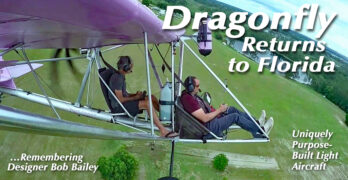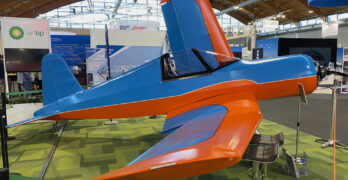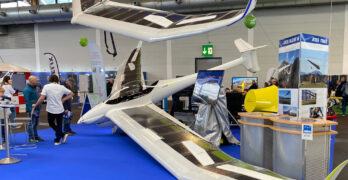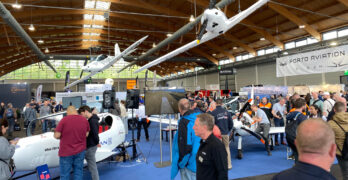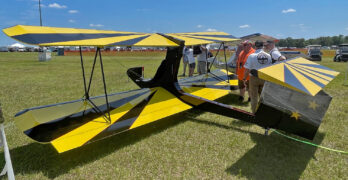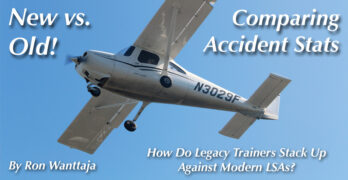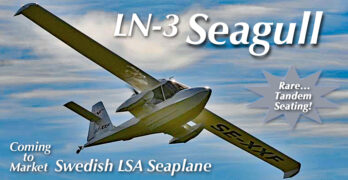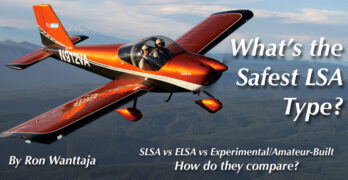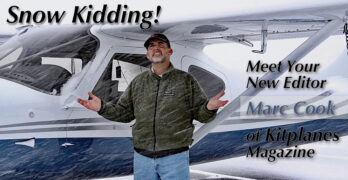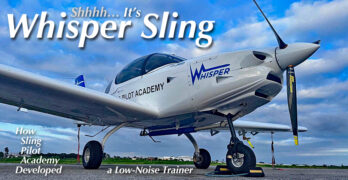Dragonfly was born in Florida in the early 1990s. Back-of-the-napkin sketches started in the 1980s following the dynamic 1970s when hang gliding swooped into national awareness. What one designer did with Dragonfly would become one of the most celebrated developments in hang gliding.
Throughout the ’70s, hang glider designs accelerated smartly in glide performance and sink rate, stretching from slope-hugging 4:1 triangular-shaped wings to elegantly long and slender “bladewings” that could exceed a 20:1 glide yet remain foot-launchable and still be an aircraft you could carry on your shoulder (when folded down). Passionate enthusiasts thrilled to a 5X performance improvement in a decade or so.
In the beginning, most pilots launched off mountains to get enough height to catch thermals. Yet lots of America doesn’t have mountainous terrain. Florida had plenty of pilots eager to fly hang gliders but to find the best soaring, they had to load up their gliders and drive 10-12 hours to the hills of Tennessee where flight park operators like me catered to them with mountain launch sites.
Search Results for : MG 21
Not finding exactly what you expected? Try our advanced search option.
Select a manufacturer to go straight to all our content about that manufacturer.
Select an aircraft model to go straight to all our content about that model.
Day 4 at AERO: A Few More Conventional Aircraft But Also a Few Surprises!
I’ll take the opportunity in this installment to take a look at some of the lighter aircraft to be seen at AERO Friedrichshafen this year.
ICP Ventura 2 and Ventura 4
Italian airframer ICP had several aircraft on display including the Ventura 2 ultralight powered by various permutations of Rotax, and also the Experimental, which as well as being fitted with a Rotax can also be powered by a Lycoming of up to 180 hp. The Venture 2 is a side-by-side two-seater, while the Ventura 4 is, as the name suggests, a four-seater specifically designed to meet the requirements of amateur construction and suitable for the Experimental category. ICP claims that a first time builder can reasonably expect to finish the aircraft in between 700 to 800 hours, while a more experienced builder with practical build experience can complete the aircraft in around 400 hours, excluding paint and upholstery. ICP also had the Savannah SR on show, and this machine bore quite a strong resemblance to the Zenith 701.
Day 3 at AERO: A Look At Sailplanes & Towplanes
The cavernous halls of the Messe truly do contain the aspirations and, let’s be honest, the dreams of literally dozens of designers. There were quite possibly more new types than I have ever seen, and I’ve been attending the Friedrichshafen show for over 20 years. Anyone who claims general aviation is dying would only need to see this show to have their viewpoint radically altered.
Gliding has always been well represented at AERO, and in the show’s 30th year all the major sailplane manufacturers were out in force. For many years AERO was a biennial event and when the organizers made it an annual show, many decided to stick with the biennial schedule and only attend on even-numbered years. There were many different permutations of self-launching and self-sustaining sailplanes on show, which utilized piston engines, electric motors and small jets.
Jonker JS3
South African company Jonker has several versions of the “engine-on-stick” solution for its JS3 single seat high performance sailplane, including an electric motor turning a two-blade propeller and a small jet.
Day 2 at AERO: The Show Gets Busier and So Does Our Correspondent!
Day Two of AERO at Friedrichshafen, and after a slow start footfall-wise yesterday there were considerably more visitors thronging the massive Messe today.
Aura Aircraft
The day started with a visit to the Aura Aircraft press conference, where the French airframer announced that it was signing a deal with the Deutsch aeroclub to use its Integra E electric two-seater as a glider tow plane. As a very experienced tug pilot and having been Tug Master at two different gliding clubs. I found this initiative both extremely interesting and very exciting. Noise and pollution are two very hot topics in Germany—and indeed most of Europe, and while all the gliding clubs are keen to promote the sport as being both green and sustainable, critics will always point to the noisy, gas guzzling Piper Pawnees and Robin DR400s and observe that it isn’t as green as they claim.
This initiative is certainly very laudable and could have significant implications for the gliding community.
Dingo—a Single Seat, Open Cockpit Biplane
On display in Paradise City (the show’s area for light planes and ultralights) are a pair of “Dingos” – a relatively new ultralight kit design from Future Vehicles, a manufacturer located in the Czech Republic (futurevehicles.eu/dingo). The Dingo is a single seat, open cockpit biplane weighing in at approx. 210 lb without engine. The airframe is riveted from sheets made of aluminum 6061 and 2024 alloys. The ailerons and elevator are operated by rods and the rudder is controlled by cables. All sheet metal parts are already drilled and it is only necessary to rivet them (matched-hole technology utilized). The construction manuals with breakdowns and part numbers are in PDF format and are available on their website for public viewing. Also, videos of each stage of construction, showing the proper sequence of assembly, are provided on the Future Vehicles website.
Rick Bennett, of Bluff City Aircraft LLC (bluffcityaircraft.com) is the US distributor for the Dingo.
Light Sport Accidents — New LSAs vs. Legacy Trainers
Editor’s Note: This is the second part of Ron Wanttaja’s survey of LSA safety (here’s the first). This time, he takes a close look at how modern LSAs compare with legacy trainers as epitomized by Cessna’s 152, both in terms of accident rates and the kinds of mayhem they succumb to. Let’s dive in!
In the previous safety review, we looked various forms of LSA—SLSA, ELSA and Experimental/Amateur-Built. For this article, we’ll look only at SLSA airplanes. We’re not addressing powered parachutes, weight shift or other SLSA classes—just traditional flying machines with wings and a motor. Call them “SLSA-A,” or “SLSA-As” for plural. We’ll address their accidents from 2005 through 2021.
To identify the SLSA-A accidents, I cross-referenced the NTSB accident database with FAA registrations, including both active and inactive aircraft.
What to compare them to? Let’s pick the near-ubiquitous Cessna 152. It’s close to the general definition of Light Sport, other than exceeding the LSA gross weight requirement.
Swedish LN-3 Seagull — Tandem-Seating LSA Seaplane …Plus, Breaking News!
LSA seaplanes are a segment all to themselves. [See Breaking News at bottom!]
It isn’t only that seaplanes can offer “triphibian” capabilities (a term once promoted by MVP) because they can operate from land, water, or snow. That makes them versatile but amphibious craft must incorporate retractable gear and since they require a sturdy hydrodynamic boat hull as well as aerodynamic aircraft structures, the engineering task becomes significantly larger than land plane designs.
Icon took years with their A5 and Vickers is still working on their Wave. Both took more than a decade to reach market. Several other LSA seaplane projects required similarly lengthy development.
Now from Svenska Flygfabriken (Swedish Aviation Factory) comes LN-3. This new entry is distinctive because it is a tandem-seating seaplane. Yes, I know lots of Cub-types on floats are tandem but among boat-hulled seaplanes, I’m not aware of any others like this.
Light Sport Accidents — How Do The Categories Compare?
Editor’s Note: This two-part short series is the handiwork of Ron Wanttaja, who has been tracking accident and registration data for Experimental aircraft for decades. Here, he looks at both the fleet size and accident rates among the various LSA categories. Looking ahead, the next installment will dig deep into how LSAs fare against more common certified trainers.
It’s been almost 20 years since the FAA implemented the Light Sport Aircraft category. While the planes might appear similar to traditional Experimental/Amateur-Built (E/A-B) aircraft, there are significant differences in how they are designed, constructed, maintained and operated.
Light Sports have had a major impact on flying in the U.S., even if their numbers are still relatively few. Without Light Sport (and the accompanying Sport Pilot program), the FAA would have lacked data to justify the simplification of pilot medicals known as BasicMed. Light Sport’s proven safety led to the MOSAIC program, featuring a major relaxation of the limits of what can be flown without an FAA medical.
Who Is This Guy, Anyway? Please Welcome, Marc Cook!
You’re probably wondering about this raspy old voice appearing on the ByDanJohnson site. Who are you and what have you done with Dan? Part of that you already know.
Dan sold this site to what was then the Flying Media Group, owned by Craig Fuller, an LSA owner himself. Since adding a bunch of marine titles from Bonnier, the overarching company is now known as Firecrown, but the aviation side is still a big part of the portfolio, including FLYING, Plane & Pilot and KITPLANES (among many others). ByDanJohnson, when it becomes Affordable Aviation, will fit like the perfect puzzle piece into the group
Speaking of KITPLANES, that’s where I come from. In fact, Dan and I have history—the good kind—as he wrote about the then-nascent LSA category for KP back when all this got started. We felt it was important to get smart about the segment since it would intersect with Experimental aircraft.
Good Neighbor! — How Sling Pilot Academy Made Their Trainer Whisper
Harley Davidson or Rotax — Sounds can be unique and associated with a certain brand. Harley motorcycles have made their sound a trademark, defending it vigorously against wannabe knock-offs.
Sling Pilot Academy found Rotax 912iS engines output a particular sound, too. However, they wanted to shield their neighbors from it. As busy as Sling Pilot Academy has become, keeping good relations is essential.
So, Whisper Sling
Necessity is the mother of invention, so the saying goes. Necessity, in this case, was success.
(SPA) at the Torrance, California, airport has grown to become a training behemoth, with their fleet flying more than 4,000 hours per month, the bulk of it in the Sling two-place LSA it uses as a primary trainer. That makes the SPA one of the busiest training companies in the region.
And Torrance, like many urban airports, faces increasing complaints from non-pilot neighbors; in fact, Torrance’s very existence has been threatened for decades by those opposed to the presence of airplanes at, get this, an airport.
- « Previous Page
- 1
- …
- 7
- 8
- 9
- 10
- 11
- …
- 94
- Next Page »


